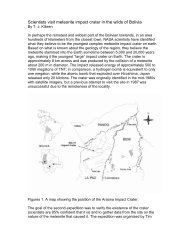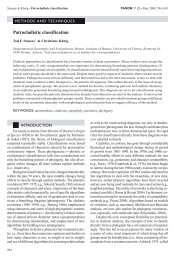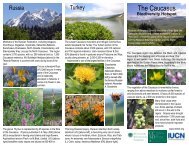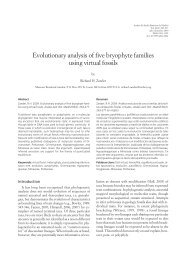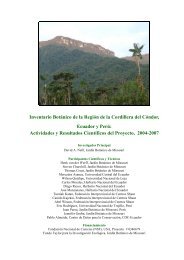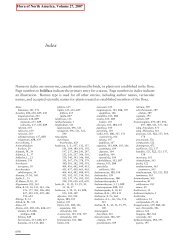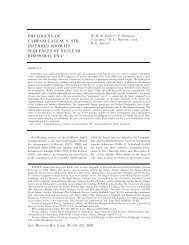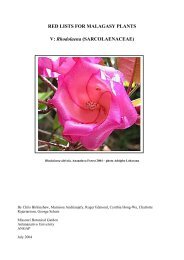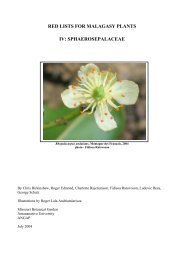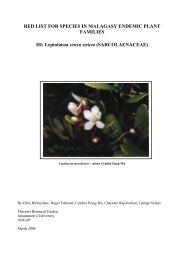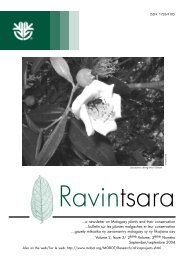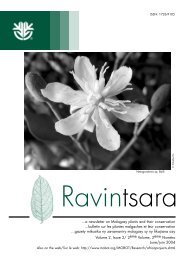re-evaluation of tortella - Missouri Botanical Garden
re-evaluation of tortella - Missouri Botanical Garden
re-evaluation of tortella - Missouri Botanical Garden
Create successful ePaper yourself
Turn your PDF publications into a flip-book with our unique Google optimized e-Paper software.
cell walls and massive pedestaled coroniform papillae,<br />
the papillae sometimes <strong>re</strong>duced and the lumen capped<br />
by a smooth, thick salient, 8–10 µm, in one collection<br />
with some cells <strong>re</strong>aching 14 µm. In cross section the<br />
abaxial and adaxial cell walls thicker than the crosswalls<br />
together with abaxial and adaxial papillae, both<br />
thicker than the height <strong>of</strong> the lumen itself. Asexual<br />
<strong>re</strong>production: sterile lateral shoots with minute or<br />
primordial leaves distant on the axis developing into<br />
foliose stems, possibly for vegetative dispersal. Sexual<br />
condition: dioicous. Perigonia in sessile buds at stem<br />
apices, inner perigonial bracts ovate and abruptly<br />
apiculate, scarcely longer than the antheridia, 0.5 mm<br />
long. Perichaetia as many as six on a stem, the stem<br />
elongating by multiple, successive, short subperichaetial<br />
innovations; outer perichaetial leaves undiffe<strong>re</strong>ntiated<br />
and appearing mo<strong>re</strong> acute than stem leaves by closely<br />
infolded distal margins; inner perichaetial leaves<br />
variable, equal to or shorter than surrounding leaves,<br />
diffe<strong>re</strong>ntiated as narrow, abb<strong>re</strong>viated laminae ending in<br />
a long, subulate awn above an inflated, sheathing<br />
hyaline base. Sporophytes: no fruiting material seen.<br />
A species <strong>of</strong> temperate and bo<strong>re</strong>al associations<br />
on sandy soil <strong>of</strong> rocky uplands or hills, rock slides, soil<br />
at the base <strong>of</strong> sandstone outcrops, cliff c<strong>re</strong>vices, ledges<br />
and bases in mesic to moist stations, probably<br />
associated closely with old post-glacial alluvium in<br />
drainage basins <strong>of</strong> lakes and rivers; in Europe on Baltic<br />
alvars and in montane or alpine stations; in North<br />
America 934–1560 m., B.C., N.W.T., Alaska, Mich,<br />
Wisc.; Europe.<br />
Herbaria examined: BUF, CANM, NY, UBC.<br />
Of the five specimens <strong>of</strong> var. densa in<br />
Molendo's herbarium (M—comm. H. Hertel), one (see<br />
above) was selected as lectotype, being collected befo<strong>re</strong><br />
the date <strong>of</strong> publication and fitting well the original<br />
authors' concept. It is beautifully <strong>re</strong>p<strong>re</strong>sented by copious<br />
material giving both short stems (0.5 cm) and long (4<br />
cm), described on the label as var. "densa, foliis b<strong>re</strong>vius<br />
acuminatis, statura compacta robustio<strong>re</strong> insignis." The<br />
Latin implies the<strong>re</strong> a<strong>re</strong> other variations that a<strong>re</strong> mo<strong>re</strong><br />
long-acuminate. The leaves on the specimen a<strong>re</strong><br />
intermediate-acuminate, without the long, narrow apices<br />
with long mucros <strong>of</strong> many specimens seen. It conforms<br />
perfectly with material from stations in northwestern<br />
North American, especially in the strongly concave<br />
adaxial surface <strong>of</strong> the costa in section with multistratose<br />
a<strong>re</strong>as beside the costa (cf. illustration, Plate 9). The<br />
European specimen exhibits the ext<strong>re</strong>mely deep sods<br />
that the species <strong>of</strong>ten attains in the Alps, compa<strong>re</strong>d to<br />
shallower sods in the comparatively drier mountains <strong>of</strong><br />
North America (Rocky Mountains).<br />
Specimens <strong>of</strong> Tortella inclinata having<br />
substrates not di<strong>re</strong>ctly associated with alluvium may<br />
<strong>re</strong>veal var. densa which seems to be associated with<br />
older, stable habitats, rather than colonizing <strong>re</strong>latively<br />
mo<strong>re</strong> <strong>re</strong>cent ones, such as does the var. inclinata. While<br />
European descriptions <strong>of</strong> T. inclinata include sandy soil<br />
associated with river banks, they also include walls and<br />
rocks (Dema<strong>re</strong>t & Castagne 1964), stations not known<br />
34<br />
for T. inclinata var. inclinata in North America. Most<br />
North American specimens a<strong>re</strong> identified as T. inclinata<br />
if bearing a cucullate apex, and T. tortuosa if an<br />
acuminate one.<br />
Braunmiller et al. (1971) discussed Tortella<br />
densa as a <strong>re</strong>latively new species after the publication<br />
by Crundwell and Nyholm (1962). After examination <strong>of</strong><br />
a series <strong>of</strong> specimens, these authors had appa<strong>re</strong>ntly<br />
decided it to be a good species, independently noting the<br />
homogeneous torsion <strong>of</strong> the leaves in well developed<br />
plants, <strong>re</strong>miniscent <strong>of</strong> that <strong>of</strong> Grimmia funalis Schimp.<br />
The authors associated the species with (calca<strong>re</strong>ous)<br />
rock c<strong>re</strong>vices, unlike the stations noted above in var.<br />
inclinata and they felt hinde<strong>re</strong>d in their generalities due<br />
to the lack <strong>of</strong> adequate herbarium specimens or their<br />
mistaken inclusion in the circumscription <strong>of</strong> other<br />
species. A station found in Bavaria by Paul (1943) is<br />
noteworthy for its occurrance on glacial moraine, "one<br />
<strong>of</strong> the richest stations for circumalpine plants in the<br />
foothills <strong>of</strong> the Alps...the appearance <strong>of</strong> the species<br />
the<strong>re</strong> suggests a glacial foothills dispersal."<br />
The occur<strong>re</strong>nce <strong>of</strong> this variety in the Alps <strong>of</strong><br />
Europe leads one to expect it to occur in the Rocky<br />
Mountains in North America south <strong>of</strong> the Canadian<br />
border. North American stations, however, a<strong>re</strong> as<br />
hitherto <strong>re</strong>ported for Tortella inclinata var. inclinata,<br />
that is, within the southern and western limit <strong>of</strong><br />
Wisconsinan glaciation, but not south <strong>of</strong> it. The<br />
specimens on which the North American occur<strong>re</strong>nce <strong>of</strong><br />
var. densa is he<strong>re</strong> based perhaps fail to show the full<br />
range <strong>of</strong> characters possible, based on ext<strong>re</strong>mes<br />
examined in European collections mainly in the g<strong>re</strong>ater<br />
deg<strong>re</strong>e <strong>of</strong> acumination, but a<strong>re</strong> very like the type<br />
specimen. Re-examination <strong>of</strong> specimens <strong>of</strong> T. tortuosa<br />
in the Rocky Mountains may ultimately <strong>re</strong>veal a mo<strong>re</strong><br />
widesp<strong>re</strong>ad distribution <strong>of</strong> T. inclinata var. densa on this<br />
continent.<br />
The single <strong>re</strong>port for Tortella inclinata in the<br />
Arctic was a citation by Stee<strong>re</strong> (1978) <strong>of</strong> a specimen<br />
<strong>re</strong>ported from the Brooks Range in Alaska, collected by<br />
Louis Jordal (2050, CANM; see specimen citation<br />
above) and published by Miller (1976). The specimen<br />
was originally identified as Tortella tortuosa but was<br />
<strong>re</strong>determined by Miller with the following note:<br />
"probably T. inclinata...but material not typical. Distal<br />
leaf cells small, ca. 10 µm; apices <strong>of</strong> even young leaves<br />
scarcely cucullate" (det. April 1975). Crum, in 1964,<br />
and Zander (1997) in a <strong>re</strong>cent t<strong>re</strong>atment <strong>of</strong> Tortella for<br />
Arctic North America, also examined the specimen and<br />
determined it to be that species. However, the stems a<strong>re</strong><br />
<strong>re</strong>ddish-orange, the leaves a<strong>re</strong> densely foliose, in cross<br />
section they have thickened superficial cell walls on<br />
both sides <strong>of</strong> the leaf section, forming pedestals on<br />
which the papillae a<strong>re</strong> developed, and a<strong>re</strong> <strong>re</strong>determined<br />
he<strong>re</strong> to be T. inclinata var. densa. Most <strong>of</strong> the leaves a<strong>re</strong><br />
acuminate, rather than cucullate, perhaps because the<br />
stems a<strong>re</strong> richly perichaetiate.<br />
Even in some specimens with short stems (less<br />
than 0.5 mm), the very thick superficial walls in<br />
transverse section and acute apices and orange color





